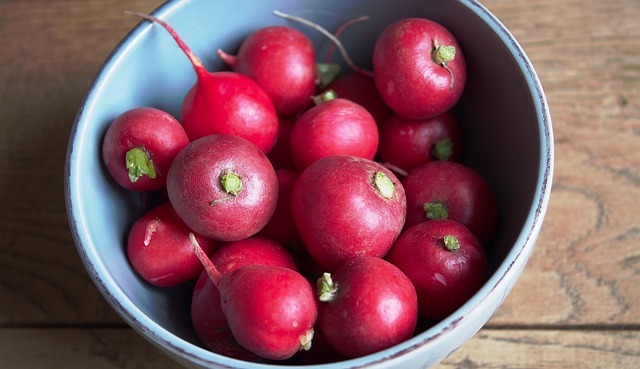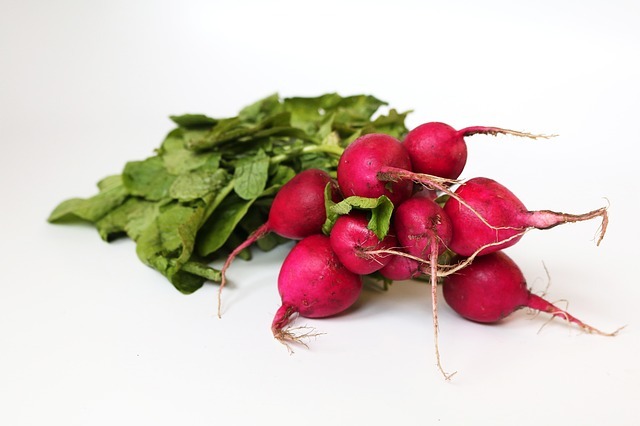The pink radish is synonymous with spring. It is often part of the raw vegetables served during friendly aperitifs with friends or family. Usually eaten raw, crunched in salt with a slice of buttered bread, more and more chefs are having fun using them in their culinary compositions. And that’s good! Because with its pretty color and spicy taste, the pink radish undoubtedly adds elegance and character to our plates. And all this with as much lightness as health benefits…
What is the pink radish?
The radish, from the Latin Raphanus sativus, is a vegetable plant of the brassica family, formerly known as cruciferous. That’s right! Radishes and cabbages are in the same family! It is a root vegetable, which means that the edible part is the underground part, although the tops of radishes are also widely used in cooking. For those of you who like a little story, the radish is believed to have originated in China several thousand years ago. There are all kinds of radishes. We are proud of this, because our little crunchy radishes are a source of inspiration as well as vitamins.
The health and nutritional benefits of pink radishes

With a particularly low caloric intake, only 15 calories per 100 grams, the radish is so rich in minerals and trace elements that it is considered to remineralize the body very effectively. It is also rich in sulphur, which gives it its pungent taste, but which, above all, makes the radish a food that stimulates the appetite and digestion. Another thing that is worth the detour with the radish: its richness in vitamin C. And vitamin C is not only found in oranges. Because 100 grams of radish cover nearly 1/3 of the recommended daily intake. The radish contributes largely to boost our immune system, to fight against fatigue (rather useful at the end of the winter) and to protect our cells from oxidative stress.
What is the season to consume the pink radish?
Even if it is available all year round, its peak season is in spring. In March, the radish is called “primeur”, and it is even better!
How to store pink radish?
The pink radish does not keep very long. The pink radish must be eaten quickly, because the longer it is left, the more it loses its crunchiness and this is one of the things that makes it so attractive. The best thing to do is to buy it in the morning and eat it at noon! But 2 to 3 days in the vegetable bin of the refrigerator, not more, is still possible. And especially without being washed before and well protected in a plastic bag. It will be necessary to wash your pink radishes at the last moment and, small trick, as the radish is sensitive to the pH, to have a pretty quite pink color, one rinses it with lemon water.
How to cook the pink radish?
In order not to alter the appearance and spicy flavor of its pretty white and crunchy flesh, it is preferable to eat the pink radish raw. But cooked, It can be nice too. It just needs to be cooked briefly. It is sautéed in a pan with a little butter or olive oil, and served with strips of beef and potatoes. Or in a wok of various crunchy vegetables, with a few drops of soy sauce and coriander! A real treat. What really deserves to be cooked, however, are the tops. And like that, no waste! In soups or purees, it is delicious.
How to choose a pink radish?
To choose your pink radish, a little tip: choose it rather small. The bigger it is, the more likely it is to be hollow inside, and that’s not good. Then, it must be firm, without cracks or stains. And finally, the aspect of the tops is essential. They must be green, it is the absolute sign of the freshness of your radishes.
Varieties of pink radish
There are three types of radish: the Japanese radish, completely unknown until recently but which is becoming fashionable, the black radish, which has a very pronounced taste and is a winter radish (see the corresponding food sheet), and the small pink radish, still called “radish of all months”. It is true that it can be found all year round on the shelves, but it is above all a spring vegetable. Among these pink radishes, there are a few different varieties that are distinguished by their shapes and colors: the Cherry radish, round and very red, the Gaudry, round and red but with the small white tip, and the half-long radish half pink and half white, the famous French radish.
How to cook the pink radish?
Traditionally, the pink radish is simply eaten raw with a little butter. But to make it lighter, you can opt for fresh cheese seasoned with chives. And for the vegans, we replace by hummus! The pink radish allows all the ideas. Presentation-wise, it’s all the same. Whole, in strips, in tulips, mixed with mixed salads, or even in skewers. With cherry tomatoes, sheep’s milk cheese or mozzarella, or even tofu, whose taste is often a bit bland. Another idea: think about sprouting radish seeds! Tasty and very pretty, you can put them everywhere. You can also pack the pink radish in a jar with vinegar. Be careful, it becomes a very powerful condiment!
If you know more informations like these, Share them with us.

